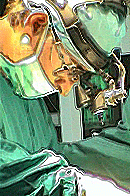|
|
|
|
|
|
|
|
Roth and Elvidge reoperated on only 13 (3 percent) of their 399 patients with glioblastoma and achieved an average additional survival of 4.5 months; it should be noted, however, that the survival of one of these patients after reoperation (17 months) was greater than the interoperative interval of 14 months. Frankel and German reoperated on 28 of their 183 patients (15.3 percent) but did not comment on the effect of these procedures, despite the fact that one patient was subjected to 5 operations. In another series, approximately 10 percent of all patients with intracerebral gliomas were reoperated on, but only 4.4 percent of the patients with glioblastoma; once again, the effectiveness of this policy was not commented on. Young and associates carefully analyzed a series of 24 reoperated cases of glioblastoma accumulated over a l2-year period and found that the length of survival after the second operation correlated significantly with the preoperative neurologic status and weakly with the length of the interoperative interval. The patients in this retrospective study were operated on at two separate institutions by a large number of neurosurgeons and represented less than 5 percent of their treated cases. Salcman M. reported a consecutive series of 74 patients admitted to an aggressive multimodality treatment program, in which reoperation was prospectively offered to all malignant astrocytoma patients prior to the institution of any new therapy, irrespective of the age of the patient, the histologic grade of the tumor, the location of the tumor, or its previous response to treatment. Reoperation was withheld when the performance status or neurological function was so poor that no further therapy of any kind was actively considered. In 36 months, 40 patients had second operations and achieved a median survival of 37 weeks from the time of reoperation. Virtually all the procedures were carried out with the aid of the operating microscope and the carbon dioxide laser in the context of aggressive multi modality treatment. There were no operative deaths in 60 reoperations. There were four serious infections; the total morbidity rate for reoperation was 8.3 percent. In Salcman series, the length of survival after the second operation was riot correlated with patient age, performance status, tumor grade, or the interoperative interval, and it was concluded that reoperation for malignant astrocytoma is safe, feasible, and of potential benefit in combination with other therapies. Several more studies have confirmed a median additional survival time of 36 to 37 weeks in reoperated patients. The routine use of reoperation to "set up" other treatment modalities deserves further study. It must be emphasized that reoperation requires exquisite attention to the details of surgical technique, because the incidence of postoperative infection is high and the condition of the tissues is often poor. The majority of patients presenting for reoperation have already failed some combination of surgery, radiation, and chemotherapy; the scalp is usually devitalized and the dura in poor repair. Parenthetically, it should be mentioned that previously irradiated gliomas are often easier to remove by virtue of their impaired blood supply. Nevertheless, firm areas of radionecrosis and calcification still pose intraoperative risks to the patient if undue manipulation results in the brain being "rocked" around; hence the great advantage of resection techniques such as the laser that do not cause visible movement of the brain.
|
|
|
Introduction |Imaging | Astrocytomas | Glioblastoma Multiforme | Oligodendrogliomas | Ependymomas | Pilocytic Astrocytomas | Gangliogliomas | Mixed Gliomas | Other Astrocytomas | Surgical treatment | Stereotactic Biopsy | Gliadel Wafers |Results and complications | When to Reoperate? | Colloid cyst
Copyright [2022] CNS Clinic - Jordan]. All rights reserved

